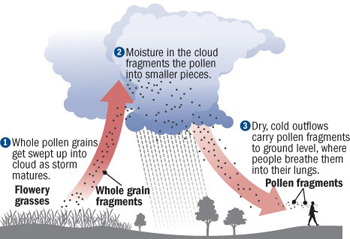A lot of people have been talking about the dangers of thunderstorm asthma recently, but not everyone knows what it is.
I want everyone to be aware of the symptoms and know how to protect themselves, so that you can all make the most of spring time in Melbourne without the worry.
So what is thunderstorm asthma?
Thunderstorm asthma occurs when lots of people get asthma symptoms over a short period of time. It is thought to be caused by a unique combination of high grass pollen counts and a certain type of thunderstorm.
You can watch this great short video from the Better Health Channel to find out more.
https://youtu.be/fWOSEo01-TQ
When does it happen?
Just like hayfever, there is a greater risk of thunderstorm asthma occurring during grass pollen season, which is usually from October to December.
What symptoms should you look out for?
If you have experienced any of the following symptoms you should speak to your doctor:
- Wheezing
- Coughing
- Shortness of breath
- Tightness in your chest
- Continued coughing
Who is at risk of thunderstorm asthma?
The people most at risk are those who experience asthma or breathing difficulties, coughs or wheezing with their hayfever. If you have experienced this, it is important that you protect yourself from thunderstorm asthma.
But even if you don’t get hayfever or asthma, you should still take care if you experience wheezing or shortness of breath. Book and appointment with your doctor if you have any concerns.
Protecting yourself
Here are my top tips for keeping yourself safe during grass pollen season.
1. Talk to your doctor if you have ever had asthma or asthmatic symptoms
Your doctor will be able to give you personal, tailored advice about how to manage your asthma
2. Take your asthma medications as prescribed
Taking your asthma preventer regularly and following the proper instructions is most important in preventing asthma and thunderstorm asthma
3. Follow your hayfever treatment plan
Taking your hayfever medications and following a treatment plan from your doctor or pharmacist can help you lower your risk. If you don’t have a treatment plan, make an appointment with your doctor.
4. Stay indoors on windy days or high grass pollen count days
If your symptoms are very bad, or you are at high risk, it is important that you monitor the outside environment. If you can avoid being outside on days when there is a very high pollen count, or at windy times before a storm, you will help protect yourself and may notice a reduction in your symptoms.
5. Keep windows and door shut
The pollen that causes these reactions can still reach you if you are indoors – so make sure you keep your windows and doors shut to lower your risk.
6. Use fans instead of air conditioning
If your air conditioning unit is bringing in air from outside, it may also be bringing in allergens that worsen your symptoms. You should either switch your air conditioning to ‘recirculate’, so it is only using internal air, or switch it off completely and use a fan instead.
7. In an emergency call 000
Asthma can be life threatening, so even if you follow all these steps, if your symptoms are getting worse and you think you need urgent care, it is critical that you call 000.
8. Look out for others
If you have friends or family with these symptoms or conditions, make sure they are OK. Often we don’t notice our symptoms getting worse but you may notice it in others. Ask them what they are doing to protect themselves, and if you are worried about them encourage them to see a doctor. In an emergency, call 000 on their behalf.
If you follow this plan and work with your health professionals to manage your condition, I hope you will be back to enjoying the warmer weather in no time!
Image produced by Asthma Australia.
